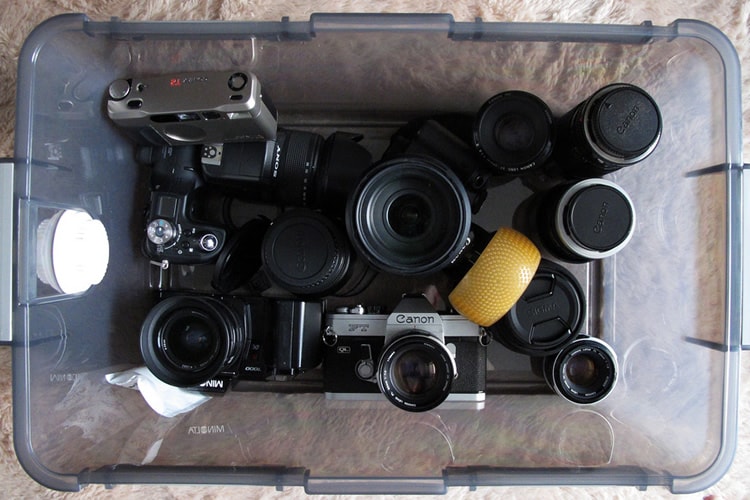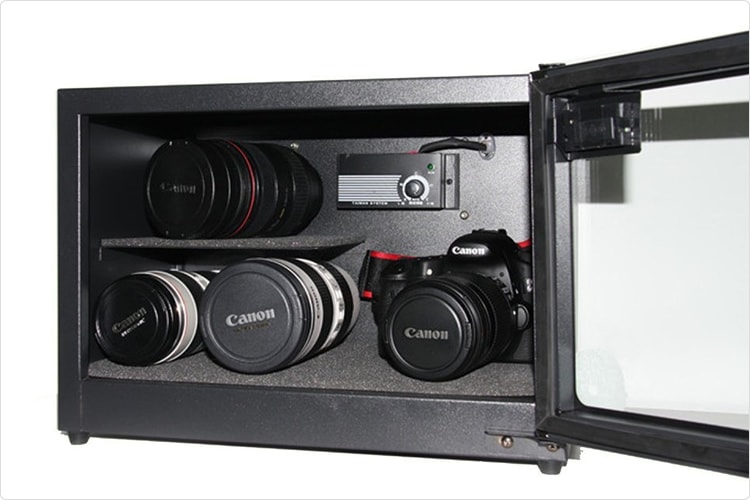The Importance Of Using A Dry Box For Your Photography Gear
If you want your dSLR camera to stay in good condition for years, you should get a good quality dry box or dry cabinet. This storage container provides the protection for your camera, as well as for all your other photography paraphernalia.
It’s an investment that every serious photographer should have in his home, studio or office.

photo by MIKI Yoshihito
The Dry Box
Imagine a box or container that looks like a refrigerator – and you have the dry box. Instead of keeping the insides cold, however, this particular container controls the humidity so your tools, especially the camera and lenses, are kept dry and safe. Inside the dry box, the temperature does not go up or down; it basically remains the same as the temperature of the room it is placed in. Ideally, an RH (Relative Humidity) range of 35 to 45% is needed in order for a dry box to provide the best protection for your photography tools.
Although dry boxes are sold in different sizes, shapes and designs, the most popular types are the small ones as they can be easily cleaned and moved. Most models or designs have shelves where you can stack your cameras, lenses and flashes, among others.
Importance of Using a Dry Box
The one word that answers the question “Why do I need a dry box for my camera?” is fungus.
Fungus is your camera’s worst enemy. It is not only difficult to clean or take off; it can damage your camera, specifically your lenses, as it is where fungus grows.
Fungus gets in between and under the lens; on your lens’ glass. When you store your camera for a long period – and without proper protection – it gets exposed to humid environments, which is where fungus thrives. Once fungus grows, it will spread quite fast; so fast that you may not notice how your other tools or equipment have already been infected. This will happen especially if you mix clean and infected lenses together in one area or container.
Another problem caused by fungus is when you force-clean the infected lens. This can damage your lens’ special coating.
Photographers who do not have dry boxes often place their cameras and photography tools in cupboards and drawers. These are dark and humid spaces, so fungus is bound to invade them in no time. To prevent this, they’ll need to use their cameras and lenses, and expose them to fresh air and light as often as possible.
Using a dry box is common to photographers who live in areas where it is humid almost the whole year round.
Dry Box Types
You can choose between two types of dry boxes.
- Electronic Dry Box – If you prefer to adjust the humidity level of your dry box on your own, the electronic dry box is perfect for you. There is a control dial for the humidity level. Some designs are connected to a digital hygrometer that you can set at a precise level. This type uses condensation in removing the moisture from the insides of the cabinet.
- Dessicant Dry Boxes – If you want a simpler (and cheaper) cabinet for your camera and lenses, go for the dessicant dry box. This type is a sealed, airtight box that contains a silica gel or any other dessicant. It’s easy to manage and more affordable than the electronic type. You can even make one on your own. The only disadvantage of this dry box type is that if you keep opening it, the dessicant might become saturated with moisture, thereby defeating the purpose of the cabinet. This dry cabinet does not come with a regulator or controller.

A dry cabinet like this can be purchased from Amazon for around $200
Choosing a Good Dry Box
Deciding which type of dry box to go for depends largely on personal preferences, which is mostly dictated by budget, among other things. However, it is also important to consider the kind of photography that you do. Are you a hobbyist? Or is photography your main source of livelihood? Is photography an art for you – more than just a hobby and a source of finances? Your answers to these questions will help you determine what kind of box you should get.
Of course, if your budget is quite tight, you might want to go for the dessicant dry box; or maybe decide on a little Do-It-Yourself project. But it’s important to always look for one of good quality. Size also matter. Don’t choose the smallest one that you see because it’s the cheapest. Make sure that it’s the right size so all your photography equipment will fit inside. Think ahead when deciding on the size, since you’re sure to buy more tools in the future. So choose one that’s not only made of durable materials, but one that has a little extra space.
You may also want to get a camera and lens dry box that you can carry around. This is smaller in size and a little like a toolbox, not a fridge. This should be your first option if you travel with your camera a lot. Some people who go trekking and kayaking use this type of dry box. There are also dry boxes for travel that look like sturdy briefcases. These boxes are usually waterproof and dust-proof, so you’re guaranteed that your equipment will be kept safe and dry even when the weather is bad.
Having a dry box, however, does not mean you should leave your camera in storage for long periods. You should take it out of the cabinet regularly, like once a month, if you do not plan on using it for weeks or months. This will help make sure that the camera is still working well, and that dust has not gathered around it.
So if you’re serious about keeping your cameras, lenses and other photography stuff in good condition – and if you want to get the best out of your investment – find a good dry box or dry cabinet. It might be a little too much for your budget, but it will do you, and your cameras, a lot of good. You won’t need to worry about your equipment getting all dusty and moist; you won’t have to battle fungus. All that you will be thinking about is how to create beautiful pictures that speak a lot of stories.
